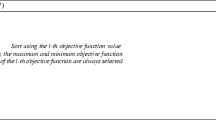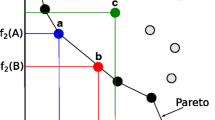Abstract
Recently, the ideal gas molecular movement (IGMM) algorithm was proposed by the authors as a new metaheuristic optimization technique for solving SOPs. In this paper, the intention is to extend the IGMM to solve MOPs while some modifications to the algorithm are taken place. The major improvement to the algorithm comprises usage of a neighbor-based non-dominated selection technique and defining a set of non-dominated solutions stored in an archive causing a globally faster convergence of the procedure. To evaluate the proposed algorithm, a set of standard benchmark problems, the so-called ZDT functions and two engineering benchmarks, are solved and the results were compared with five known multi-objective algorithms provided in the literature. Three different performance metrics; generational distance, spacing and maximum spread are introduced as well to evaluate multi-objective optimization problems. The Wilcoxon’s rank-sum nonparametric statistical test was also attempted which resulted on the fact that the proposed algorithm may exhibit a significantly better performance than those other techniques. The results from the real engineering applications also prove the advancement of the MO-IGMM performance in practice. Compared to five other multi-objective optimization evolutionary algorithms, simulation results show that in most cases, the proposed MO-IGMM is capable to find a much better uniformly spread of solutions with a faster convergence to the true Pareto optimal front.











Similar content being viewed by others
References
Wang G-G, Deb S, Cui Z (2015) Monarch butterfly optimization. Neural Comput Appl. doi:10.1007/s00521-015-1923-y
Mirjalili S (2015) Moth-flame optimization algorithm: a novel nature-inspired heuristic paradigm. Knowl Based Syst. doi:10.1016/j.knosys.2015.07.006
Wang GG, Deb S, Coelho LSDS (2015) Earthworm optimization algorithm: a bioinspired metaheuristic algorithm for global optimization problems. Int J BioInspired Comput (in press)
Wang GG, Deb S, Gao XZ, Coelho LDS (2016) A new metaheuristic optimization algorithm motivated by elephant herding behavior. Int J BioInspired Comput (in press)
Gandomi AH (2014) Interior search algorithm (ISA): a novel approach for global optimization. ISA Trans 53:1168–1183
Wang G-G, Guo L, Wang H et al (2014) Incorporating mutation scheme into krill herd algorithm for global numerical optimization. Neural Comput Appl 24:853–871. doi:10.1007/s00521-012-1304-8
Wang G-G, Gandomi AH, Alavi AH (2014) An effective krill herd algorithm with migration operator in biogeography-based optimization. Appl Math Model 38:2454–2462. doi:10.1016/j.apm.2013.10.052
Guo L, Wang G-G, Gandomi AH et al (2014) A new improved krill herd algorithm for global numerical optimization. Neurocomputing 138:392–402. doi:10.1016/j.neucom.2014.01.023
Wang G-G, Gandomi AH, Alavi AH (2013) Stud krill herd algorithm. Neurocomputing 128:1–8. doi:10.1016/j.neucom.2013.08.031
Wang GG, Gandomi AH, Yang XS, Alavi AH (2014) A novel improved accelerated particle swarm optimization algorithm for global numerical optimization. Eng Comput Int J Comput Aided Eng Softw. doi:10.1108/EC-10-2012-0232
Wang G-G, Lu M, Dong Y-Q, Zhao X-J (2016) Self-adaptive extreme learning machine. Neural Comput Appl 27:291–303. doi:10.1007/s00521-015-1874-3
Wang GG, Gandomi AH, Yang XS, Alavi AH (2015) A new hybrid method based on krill herd and cuckoo search for global optimisation tasks Xin-She Yang. Int J BioInspired Comput (in press)
Wang GG, Gandomi AH, Alavi AH, Deb S (2015) A hybrid method based on krill herd and quantum-behaved particle swarm optimization. Neural Comput Appl. doi:10.1007/s00521-015-1914-z
Wang G-G, Guo L, Gandomi AH et al (2014) Chaotic Krill Herd algorithm. Inf Sci (Ny) 274:17–34. doi:10.1016/j.ins.2014.02.123
Wang G-G, Gandomi AH, Alavi AH (2013) A chaotic particle-swarm krill herd algorithm for global numerical optimization. Kybernetes 42:962–978. doi:10.1108/K-11-2012-0108
Wang G-G, Deb S, Gandomi AH et al (2015) Chaotic cuckoo search. Soft Comput. doi:10.1007/s00500-015-1726-1
Dizangian B, Ghasemi MR (2015) Ranked-based sensitivity analysis for size optimization of structures. J Mech Des. doi:10.1115/1.4031295
Odu GO, Charles-Owaba OE (2013) Review of multi-criteria optimization methods—theory and applications. IOSR J Eng 3:01–14. doi:10.9790/3021-031020114
Coello CAC, Van Veldhuizen DA, Lamont GB (2002) Evolutionary algorithms for solving multi-objective problems. Springer, New York
Dai C, Wang Y, Ye M (2015) A new multi-objective particle swarm optimization algorithm based on decomposition. Inf Sci (Ny) 325:541–557. doi:10.1016/j.ins.2015.07.018
Mirjalili S, Lewis A, Mirjalili SAM (2015) Multi-objective optimisation of marine propellers. Procedia Comput Sci 51:2247–2256. doi:10.1016/j.procs.2015.05.504
Ghasemi MR, Farshchin M (2011) Ant colony optimisation-based multiobjective frame design under seismic conditions. Proc ICE Struct Build 164:421–432
Liris S, Solnon C, Umr C (2010) Ant colony optimization for multi-objective optimization problems. In: 19th IEEE International Conference Tools with Artificial Intelligence. 10.1109/ICTAI.2007.108
Ghasemi MR, Farshchin M (2009) Multi-objective weight and eigenperiod optimization of steel moment frames under seismic conditions, using ant colony method. In: Proceedings of 8th World Congress on Structural Multidisciplinary Optimization, Lisbon, Portugal. Paper no. 1362
Ali M, Siarry P, Pant M (2012) An efficient differential evolution based algorithm for solving multi-objective optimization problems. Eur J Oper Res 217:404–416
Kotinis M (2014) Improving a multi-objective differential evolution optimizer using fuzzy adaptation and K-medoids clustering. Soft Comput 18:757–771
Jiang SW, Zhang J, Ong YS (2014) Multiobjective optimization based on reputation. Inf Sci (Ny) 286:125–146. doi:10.1016/J.Ins.2014.07.020
Gong M, Jiao L, Du H, Bo L (2008) Multiobjective immune algorithm with nondominated neighbor-based selection. Evol Comput 16:225–255. doi:10.1162/evco.2008.16.2.225
Gao J, Wang J (2010) WBMOAIS: a novel artificial immune system for multiobjective optimization. Comput Oper Res 37:50–61
Bandyopadhyay S, Saha S, Maulik U, Deb K (2007) A simulated annealing based multi-objective optimization algorithm: AMOSA. IEEE Trans Evol Comput 12:269–283. doi:10.1109/TEVC.2007.900837
Suppapitnarm A, Seffen KA, Parks GT, Clarkson PJ (2000) A simulated annealing algorithm for multiobjective optimization. Eng Optim 33:59–85. doi:10.1080/03052150008940911
Sadollah A, Eskandar H, Hoon J (2015) Water cycle algorithm for solving constrained multi-objective optimization problems. Appl Soft Comput J 27:279–298. doi:10.1016/j.asoc.2014.10.042
Yang X (2011) Bat algorithm for multi-objective optimisation. Int J BioInspired Comput 3:267–274. doi:10.1504/IJBIC.2011.042259
Yang X (2013) Multiobjective firefly algorithm for continuous optimization. Eng Comput 29:175–184
Niu B, Wang H, Wang J, Tan L (2013) Multi-objective bacterial foraging optimization. Neurocomputing 116:336–345. doi:10.1016/j.neucom.2012.01.044
Lahoz D, Lacruz B, Mateo PM (2013) A multi-objective micro genetic ELM algorithm. Neurocomputing 111:90–103. doi:10.1016/j.neucom.2012.11.035
Costa e Silva MA, Coelho LDS, Lebensztajn L (2012) Multiobjective biogeography-based optimization based on predator-prey approach. Magn IEEE Trans 48:951–954
Zitzler E, Thiele L (1999) Multiobjective evolutionary algorithms: a comparative case study and the strength Pareto approach. Evol Comput IEEE Trans 3:257–271. doi:10.1109/4235.797969
Zitzler E, Laumanns M, Thiele L, et al (2001) SPEA2: Improving the strength pareto evolutionary algorithm. 95–100. doi:10.1.1.28.7571
Knowles JD, Corne DW (2000) Approximating the nondominated front using the Pareto archived evolution strategy. Evol Comput 8:149–172
Deb K (1999) Multi-objective genetic algorithms: problem difficulties and construction of test problems. Evol Comput 7:205–230. doi:10.1162/evco.1999.7.3.205
Coelho LDS, Alotto P, Alotto P (2008) Multiobjective electromagnetic optimization based on a nondominated sorting genetic approach with a chaotic crossover operator. Magn IEEE Trans 44:1078–1081. doi:10.1109/TMAG.2007.916027
Deb K, Pratab S, Agarwal S et al (2002) A fast and elitist multiobjective genetic algorithm: NGSA-II. IEEE Trans Evol Comput 6:182–197. doi:10.1109/4235.996017
Madhkhan M, Kianpour A, Harchegani MET, Torki Harchegani ME (2013) Life-cycle cost optimization of prestressed simple-span concrete bridges with simple and spliced girders. Iran J Sci Technol Trans Civ Eng 37:53–66
Coello CAC, Pulido GT, Lechuga MS (2004) Handling multiple objectives with particle swarm optimization. Evol Comput IEEE Trans 8:256–279
Coelho LDS, Ayala HVH, Alotto P (2010) A multiobjective gaussian particle swarm approach applied to electromagnetic optimization. IEEE Trans Magn 46:3289–3292. doi:10.1109/TMAG.2010.2047250
Varaee H, Ghasemi MR (2016) Engineering optimization based on ideal gas molecular movement algorithm. Eng Comput. doi:10.1007/s00366-016-0457-y
Moore FL (1963) Kinetic theory of gases. Am J Phys 31:213. doi:10.1119/1.1969378
Hirschfelder JO, Curtiss CF, Byron Bird R (1966) The molecular theory of gases and liquids. Wiley, London
Harsha K (2005) Principles of physical vapor deposition of thin films. Eur J Contracept Reprod Health Care 6:1155. doi:10.1016/B978-081551442-8.50020-1
Marler RT, Arora JS (2004) Survey of multi-objective optimization methods for engineering. Struct Multidiscip Optim 26:369–395
Knowles JD, Corne DW (1999) Local search, multiobjective optimization and the Pareto archived evolution strategy. In: Proc. Third Aust. Jt. Work. Intell. Evol. Syst, pp 209–216
Coello CAC (2009) Evolutionary multi-objective optimization: some current research trends and topics that remain to be explored. Front Comput Sci China 3:18–30
Coello CAC, Reyes-Sierra M (2006) Multi-objective particle swarm optimizers: a survey of the state-of-the-art. Int J Comput Intell Res 2:287–308. doi:10.5019/j.ijcir.2006.68
Mirjalili S, Lewis A (2015) Novel performance metrics for robust multi-objective optimization algorithms. Swarm Evol Comput 21:1–23
Mirjalili S (2015) Dragonfly algorithm: a new meta-heuristic optimization technique for solving single-objective, discrete, and multi-objective problems. Neural Comput Appl. doi:10.1007/s00521-015-1920-1
Branke J, Kaußler T, Schmeck H (2001) Guidance in evolutionary multi-objective optimization. Adv Eng Softw 32:499–507
Wilcoxon F (1945) Individual comparisons by ranking methods. Biom Bull 1:80–83. doi:10.2307/3001968
Derrac J, García S, Molina D, Herrera F (2011) A practical tutorial on the use of nonparametric statistical tests as a methodology for comparing evolutionary and swarm intelligence algorithms. Swarm Evol Comput 1:3–18. doi:10.1016/j.swevo.2011.02.002
Mirjalili SM, Mirjalili SM, Yang X-SS (2013) Binary bat algorithm. Neural Comput Appl 25:663–681. doi:10.1007/s00521-013-1525-5
Zhang Q, Li H (2007) MOEA/D: a multiobjective evolutionary algorithm based on decomposition. Evol Comput IEEE Trans 11:712–731. doi:10.1109/TEVC.2007.892759
Corne DW, Knowles JD, Oates MJ (2000) The Pareto envelope-based selection algorithm for multiobjective optimization. In: Parallel Problem Solving from Nature PPSN VI, pp 839–848
Dai C, Wang Y (2015) A new decomposition based evolutionary algorithm with uniform designs for many-objective optimization. Appl Soft Comput 30:238–248. doi:10.1016/j.asoc.2015.01.062
Kaveh A, Laknejadi K (2013) A new multi-swarm multi-objective optimization method for structural design. Adv Eng Softw J 58:54–69. doi:10.1016/j.advengsoft.2013.01.004
Zitzler E, Deb K, Thiele L (2000) Comparison of multiobjective evolutionary algorithms: empirical results. Evol Comput 8:173–195
Deb K, Sinha A, Kukkonen S (2006) Multi-objective test problems, linkages, and evolutionary methodologies. In: Proceedings of the 8th Annual Conference on Genetic and Evolutionary Computation ACM, pp 1141–1148
Lagaros ND, Plevris V, Papadrakakis M (2005) Multi-objective design optimization using cascade evolutionary computations. Comput Methods Appl Mech Eng 194:3496–3515. doi:10.1016/j.cma.2004.12.029
Amouzgar K, Rashid A, Stromberg N (2013) Multi-objective optimization of a disc brake system by using spea2 and RBFN. Am Soc Mech Eng. doi:10.1115/DETC2013-12809
Alimi A, Zandieh M, Amiri M (2012) Multi-objective portfolio optimization of mutual funds under downside risk measure using fuzzy theory. Int J Ind Eng Comput 3:859–872. doi:10.5267/j.ijiec.2012.05.005
Balasubbareddy M, Sivanagaraju S, Suresh CV (2015) Multi-objective optimization in the presence of practical constraints using non-dominated sorting hybrid cuckoo search algorithm. Eng Sci Technol Int J 18:603–615. doi:10.1016/j.jestch.2015.04.005
Pham D, Ghanbarzadeha A (2007) Multi–objective optimisation using the bees algorithm. In: Memorias del Innov. Prod. Mach. Syst. Virtual Conf, pp 529–533
Yang X-SS, Deb S (2013) Multiobjective cuckoo search for design optimization. Comput Oper Res 40:1616–1624. doi:10.1016/j.cor.2011.09.026
Jancirani J, Chandrasekaran S, Tamilporai P (2004) Optimum design of disc brake parameters using genetic algorithm. Int J Innov Res Sci Eng Technol 3:1400–1405
Author information
Authors and Affiliations
Corresponding author
Ethics declarations
Conflict of interest
The authors declare that they have no conflict of interest.
Rights and permissions
About this article
Cite this article
Ghasemi, M.R., Varaee, H. A fast multi-objective optimization using an efficient ideal gas molecular movement algorithm. Engineering with Computers 33, 477–496 (2017). https://doi.org/10.1007/s00366-016-0485-7
Received:
Accepted:
Published:
Issue Date:
DOI: https://doi.org/10.1007/s00366-016-0485-7




